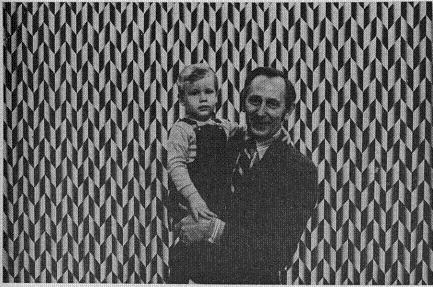My father, also Kazys Varnelis, passed away on Friday morning after a long illness. Born in Alsedžiai, Lithuania in 1917, his father too was Kazys Varnelis, a noted Samogitian folk artist and cross-carver.
Briefly the director of the Museum of Ecclesiastical Art in Kaunas, he fled after the Soviet invasion and eventually settled in Chicago. After more than a decade running a studio that designed church interiors and stained glass, he turned to geometric abstraction in the early1960s. His work from this period recalls the ornament of Lithuanian folk art while also experimenting with the flatness of the canvas and the contradictions in geometric patterns that are painted using the classical convention of light coming from the upper left of the canvas. He exhibited widely in the United States in places like the Art Institute of Chicago, the Museum of Contemporary Art, Milwaukee Art Center, and Corcoran Gallery. His work is in collections across the country, from the MCA to the Guggenheim. In 1978, we moved to Stockbridge, Massachusetts where he purchased a decrepit old estate that he restored as a venue for his increasingly large works.
He also collected books and furniture and, when Lithuania became free in 1991 and offered him a museum to house his work, he welcomed the opportunity. Beginning this new project over eighty years of age, he had finally was able to realize his dream of returning to his homeland and to give his works and collections to the country he held so dear.
We are going to Lithuania on Monday to attend the funeral with my mother. He will be missed, but I am glad he had a chance to live a long and fruitful life. Here is a picture of the two of us in the best of days and here is an article on his work for those of you unfamiliar with it.

My father, also Kazys Varnelis, passed away on Friday morning after a long illness. Born in Alsedžiai, Lithuania in 1917, his father too was Kazys Varnelis, a noted Samogitian folk artist and cross-carver.
Briefly the director of the Museum of Ecclesiastical Art in Kaunas, he fled after the Soviet invasion and eventually settled in Chicago. After more than a decade running a studio that designed church interiors and stained glass, he turned to geometric abstraction in the early1960s. His work from this period recalls the ornament of Lithuanian folk art while also experimenting with the flatness of the canvas and the contradictions in geometric patterns that are painted using the classical convention of light coming from the upper left of the canvas. He exhibited widely in the United States in places like the Art Institute of Chicago, the Museum of Contemporary Art, Milwaukee Art Center, and Corcoran Gallery. His work is in collections across the country, from the MCA to the Guggenheim. In 1978, we moved to Stockbridge, Massachusetts where he purchased a decrepit old estate that he restored as a venue for his increasingly large works.
He also collected books and furniture and, when Lithuania became free in 1991 and offered him a museum to house his work, he welcomed the opportunity. Beginning this new project over eighty years of age, he had finally was able to realize his dream of returning to his homeland and to give his works and collections to the country he held so dear.
We are going to Lithuania on Monday to attend the funeral with my mother. He will be missed, but I am glad he had a chance to live a long and fruitful life. Here is a picture of the two of us in the best of days and here is an article on his work for those of you unfamiliar with it.

